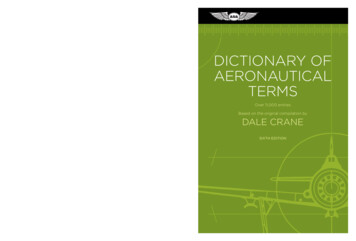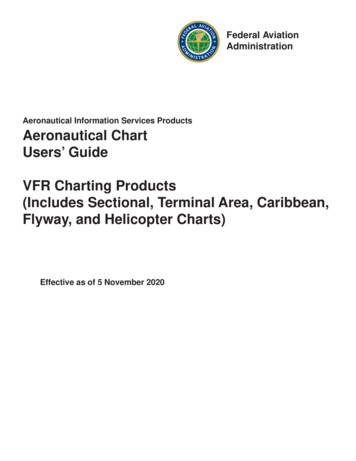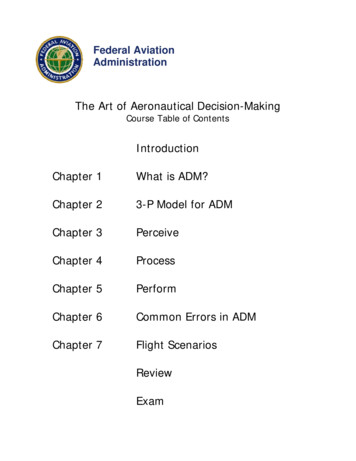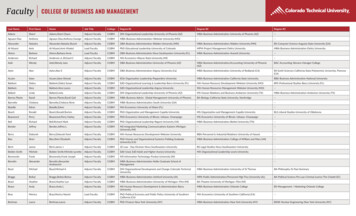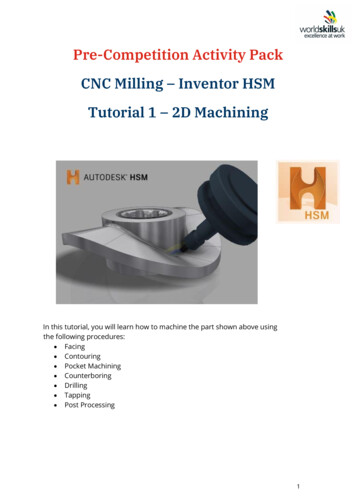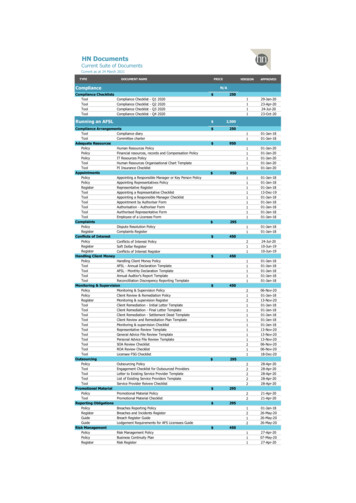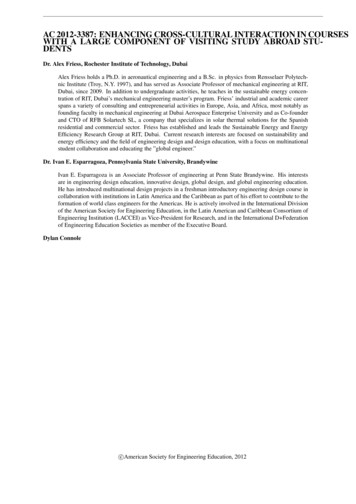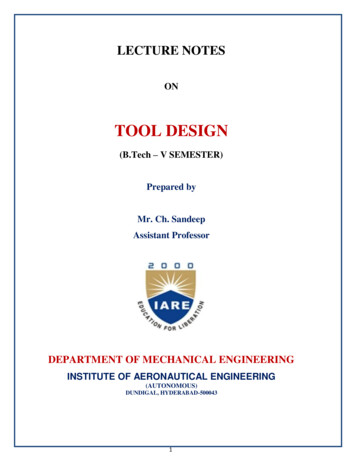
Transcription
LECTURE NOTESONTOOL DESIGN(B.Tech – V SEMESTER)Prepared byMr. Ch. SandeepAssistant ProfessorDEPARTMENT OF MECHANICAL ENGINEERINGINSTITUTE OF AERONAUTICAL ENGINEERING(AUTONOMOUS)DUNDIGAL, HYDERABAD-5000431
UNIT-ITOOL MATERIALNeeds and Chronological Development of Cutting Tool Materials:With the progress of the industrial world it has been needed to continuously develop and improve thecutting tool materials and geometry; To meet the growing demands for high productivity, quality and economy of machining To enable effective and efficient machining of the exotic materials that are coming upwith the rapid and vast progress of science and technology For precision and ultra-precision machining For micro and even nano machining demanded by the day and future.It is already stated that the capability and overall performance of the cutting tools depend upon, The cutting tool materials The cutting tool geometry Proper selection and use of those tools The machining conditions and the environmentsOut of which the tool material plays the most vital role.The relative contribution of the cutting tool materials on productivity, for instance, can be roughlyassessed from Fig. 1.1Fig. 1.1 Productivity raised by cutting tool materials.The chronological development of cutting tool materials is briefly indicated in Fig. 1.22
Characteristics and Applications of the Primary Cutting Tool Materials:(a) High Speed Steel (HSS)Advent of HSS in around 1905 made a break through at that time in the history of cutting tool materialsthough got later superseded by many other novel tool materials like cemented carbides and ceramicswhich could machine much faster than the HSS tools.The basic composition of HSS is 18% W, 4% Cr, 1% V, 0.7% C and rest Fe. Such HSS tool couldmachine (turn) mild steel jobs at speed only upto 20 30 m/min (which was quite substantial those days)Fig. 1.2 Chronological Development of cutting tool materialsHowever, HSS is still used as cutting tool material where; The tool geometry and mechanics of chip formation are complex, such as helical twist drills,reamers, gear shaping cutters, hobs, form tools, broaches etc. Brittle tools like carbides, ceramics etc. are not suitable under shock loading The small scale industries cannot afford costlier tools The old or low powered small machine tools cannot accept high speed and feed. The tool is to be used number of times by re-sharpening.3
With time the effectiveness and efficiency of HSS (tools) and their application range were graduallyenhanced by improving its properties and surface condition through Refinement of microstructure Addition of large amount of cobalt and Vanadium to increase hot hardness and wearresistance respectively Manufacture by powder metallurgical process Surface coating with heat and wear resistive materials like TiC, TiN, etc by ChemicalVapor Deposition (CVD) or Physical Vapor Deposition (PVD)The commonly used grades of HSS are given in Table 1.1.Table 1.1 Compositions and types of popular high speed steelsAddition of large amount of Co and V, refinement of microstructure and coating increased strength andwear resistance and thus enhanced productivity and life of the HSS tools remarkably.(b) StelliteThis is a cast alloy of Co (40 to 50%), Cr (27 to 32%), W (14 to 19%) and C (2%). Stellite is quite toughand more heat and wear resistive than the basic HSS (18 – 4 – 1) But such stellite as cutting tool materialbecame obsolete for its poor grindability and especially after the arrival of cemented carbides.(c) Sintered Tungsten carbidesThe advent of sintered carbides made another breakthrough in the history of cutting tool materials.Straight or single carbide:First the straight or single carbide tools or inserts were powder metallurgically produced by mixing,compacting and sintering 90 to 95% WC powder with cobalt. The hot, hard and wear resistant WC grainsare held by the binder Co which provides the necessary strength and toughness. Such tools are suitable for4
machining grey cast iron, brass, bronze etc. which produce short discontinuous chips and at cuttingvelocities two to three times of that possible for HSS tools.Disadvantages: The single carbide is not suitable for machining steels because of rapid growth of wear,particularly crater wear, by diffusion of Co and carbon from the tool to the chip under the high stress andtemperature bulk (plastic) contact between the continuous chip and the tool surfaces.Composite carbides:For machining steels successfully, another type called composite carbide have been developed by adding(8 to 20%) a gamma phase to WC and Co mix. The gamma phase is a mix of TiC, TiN, TaC, NiC etc.which are more diffusion resistant than WC due to their more stability and less wettability by steel.Mixed carbides:Titanium carbide (TiC) is not only more stable but also much harder than WC. So for machining ferriticsteels causing intensive diffusion and adhesion wear a large quantity (5 to 25%) of TiC is added with WCand Co to produce another grade called Mixed carbide. But increase in TiC content reduces the toughnessof the tools. Therefore, for finishing with light cut but high speed, the harder grades containing upto 25%TiC are used and for heavy roughing work at lower speeds lesser amount (5 to 10%) of TiC is suitable.Gradation of cemented carbides and their applications:The standards developed by ISO for grouping of carbide tools and their application ranges are given inTable 1.2.Table 1.2 Broad classifications of carbide tools.5
K-group is suitable for machining short chip producing ferrous and non-ferrous metals and alsosome non metals. P-group is suitably used for machining long chipping ferrous metals i.e. plain carbon and lowalloy steels M-group is generally recommended for machining more difficult-to-machine materials likestrain hardening austenitic steel and manganese steel etc.Table 2.3 Detail grouping of cemented carbide toolsThe smaller number refers to the operations which need more wear resistance and the larger numbers tothose requiring higher toughness for the tool.6
(d) Plain ceramicsInherently high compressive strength, chemical stability and hot hardness of the ceramics led to powdermetallurgical production of indexable ceramic tool inserts since 1950. Table 2.4 shows the advantages andlimitations of alumina ceramics in contrast to sintered carbide. Alumina (Al2O3) is preferred to siliconnitride (Si3N4) for higher hardness and chemical stability. Si3N4 is tougher but again more difficult toprocess. The plain ceramic tools are brittle in nature and hence had limited applications.Table 1.4 Cutting tool properties of alumina ceramics.* Cutting tool should resist penetration of heat but should disperse the heat throughout the core.Basically three types of ceramic tool bits are available in the market; Plain alumina with traces of additives – these white or pink sintered inserts are cold pressed and areused mainly for machining cast iron and similar materials at speeds 200 to 250 m/min Alumina; with or without additives – hot pressed, black colour, hard and strong – used formachining steels and cast iron at Vc 150 to 250 m/min Carbide ceramic (Al2 O3 30% TiC) cold or hot pressed, black colour, quite strong and enoughtough – used for machining hard cast irons and plain and alloy steels at 150 to 200 m/min.The plain ceramic outperformed the then existing tool materials in some application areas like highspeed machining of softer steels mainly for higher hot hardness as indicated in Fig. 1.37
Fig. 1.3 Hot hardness of the different commonly used tool materials.(Ref. Book by A.Bhattacharya)However, the use of those brittle plain ceramic tools, until their strength and toughness could besubstantially improved since 1970, gradually decreased for being restricted to Uninterrupted machining of soft cast irons and steels only Relatively high cutting velocity but only in a narrow range (200 300 m/min) Requiring very rigid machine toolsAdvent of coated carbide capable of machining cast iron and steels at high velocity made the then ceramicsalmost obsolete.Coated carbides:The properties and performance of carbide tools could be substantially improved by Refining microstructure Manufacturing by casting – expensive and uncommon Surface coating – made remarkable contribution.8
Thin but hard coating of single or multilayers of more stable and heat and wear resistive materials likeTiC, TiCN, TiOCN, TiN, Al2 O3 etc on the tough carbide inserts (substrate) (Fig. 2.4) by processes likechemical Vapour Deposition (CVD), Physical Vapour Deposition (PVD) etc at controlled pressure andtemperature enhanced MRR and overall machining economy remarkably enabling, Reduction of cutting forces and power consumption Increase in tool life (by 200 to 500%) for same V or increase in V (by 50 to 150%) for same tool life Improvement in product quality Effective and efficient machining of wide range of work materials Pollution control by less or no use of cutting fluid through Reduction of abrasion, adhesion and diffusion wear Reduction of friction and BUE (Built up edge) formation Heat resistance and reduction of thermal cracking and plastic deformationThe contributions of the coating continue even after rupture of the coating as indicated in Fig. 1.5.Fig. 1.5 Role of coating even after its wear and ruptureThe cutting velocity range in machining mild steel could be enhanced from 120 150 m/min to 300 350 m/min by properly coating the suitable carbide inserts.About 50% of the carbide tools being used at present are coated carbides which are obviously to someextent costlier than the uncoated tools.9
Different varieties of coated tools are available. The appropriate one is selected depending upon the typeof the cutting tool, work material and the desired productivity and product quality.The properties and performances of coated inserts and tools are getting further improved by; Refining the microstructure of the coating Multilayering (already upto 13 layers within 12 16 μm) Direct coating by TiN instead of TiC, if feasible Using better coating materials.Cutting Fluid:The basic purposes of cutting fluid application are : Cooling of the job and the tool to reduce the detrimental effects of cutting temperature on the joband the tool Lubrication at the chip–tool interface and the tool flanks to reduce cutting forces and friction andthus the amount of heat generation. Cleaning the machining zone by washing away the chip – particles and debris which, if present,spoils the finished surface and accelerates damage of the cutting edges Protection of the nascent finished surface – a thin layer of the cutting fluid sticks to the machinedsurface and thus prevents its harmful contamination by the gases like SO , O , H S, N O presentin the atmosphere.However, the main aim of application of cutting fluid is to improve machinability through reduction ofcutting forces and temperature, improvement by surface integrity and enhancement of tool life.Essential properties of cutting fluids:To enable the cutting fluid fulfill its functional requirements without harming the Machine – Fixture –Tool – Work (M-F-T-W) system and the operators, the cutting fluid should possess the followingproperties:10
For cooling: High specific heat, thermal conductivity and film coefficient for heat transfer Spreading and wetting abilityFor lubrication:High lubricity without gumming and foamingWetting and spreadingHigh film boiling pointFriction reduction at extreme pressure (EP) and temperatureChemical stability, non-corrosive to the materials of the M-F-T-W systemLess volatile and high flash pointHigh resistance to bacterial growthOdorless and also preferably colorlessNon toxic in both liquid and gaseous stageEasily available and low cost.Types of cutting fluids and their application:Generally, cutting fluids are employed in liquid form but occasionally also employed in gaseous form.Only for lubricating purpose, often solid lubricants are also employed in machining and grinding.The cutting fluids, which are commonly used, are: Air blast or compressed air only: Machining of some materials like grey cast iron becomeinconvenient or difficult if any cutting fluid is employed in liquid form. In such case only airblast is recommended for cooling and cleaning Water: For its good wetting and spreading properties and very high specific heat, water isconsidered as the best coolant and hence employed where cooling is most urgent. Soluble oil: Water acts as the best coolant but does not lubricate. Besides, use of only water mayimpair the machine-fixture-tool-work system by rusting So oil containing some emulsifyingagent and additive like EPA, together called cutting compound, is mixed with water in a suitableratio ( 1 2 in 20 50). This milk like white emulsion, called soluble oil, is very common andwidely used in machining and grinding.11
Cutting oils: Cutting oils are generally compounds of mineral oil to which are added desired typeand amount of vegetable, animal or marine oils for improving spreading, wetting and lubricatingproperties. As and when required some EP additive is also mixed to reduce friction, adhesion andBUE formation in heavy cuts. Chemical fluids: These are occasionally used fluids which are water based where some organicand or inorganic materials are dissolved in water to enable desired cutting fluid action.There are two types of such cutting fluid; Chemically inactive type – high cooling, anti-rusting and wetting but less lubricating Active (surface) type – moderate cooling and lubricating. Solid or semi-solid lubricant: Paste, waxes, soaps, graphite, Moly-disulphide (MoS2 ) may alsooften be used, either applied directly to the workpiece or as an impregnant in the tool to reducefriction and thus cutting forces, temperature and tool wear. Cryogenic cutting fluid: Extremely cold (cryogenic) fluids (often in the form of gases) like liquidCO2 or N2 are used in some special cases for effective cooling without creating muchenvironmental pollution and health hazards.Selection of Cutting Fluid:The benefit of application of cutting fluid largely depends upon proper selection of the type of thecutting fluid depending upon the work material, tool material and the machining condition. As forexample, for high speed machining of not-difficult-to-machine materials greater cooling type fluidsare preferred and for low speed machining of both conventional and difficult-to-machine materialsgreater lubricating type fluid is preferred. Selection of cutting fluids for machining some commonengineering materials and operations are presented as follows:Grey cast iron:Generally dry for its self lubricating propertyAir blast for cooling and flushing chipsSoluble oil for cooling and flushing chips in high speed machining and grindingSteels:If machined by HSS tools, sol. Oil (1: 20 30) for low carbon and alloy steels and neat oil with EPA forheavy cuts.12
If machined by carbide tools thinner sol. Oil for low strength steel, thicker sol. Oil ( 1:10 for strongersteels and straight sulphurised oil for heavy and low speed cuts and EP cutting oil for high alloy steel.Often steels are machined dry by carbide tools for preventing thermal shocks. Aluminium and its alloys:ƒ Preferably machined dry ƒLight but only soluble oilƒStraight neat oil or kerosene oil for stringent cuts.Copper and its alloys : ƒWater based fluids are generally usedƒOil with or without inactive EPA for tougher grades of Cu-alloy.Stainless steels and Heat resistant alloys:ƒHigh performance soluble oil or neat oil with high concentration with chlorinated EPadditive.The brittle ceramics and cermets should be used either under dry condition or light neat oil in case of finefinishing.Grinding at high speed needs cooling ( 1: 50 100) soluble oil. For finish grinding of metals and alloyslow viscosity neat oil is also used.Sources and causes of heat generation and development of temperature in machining:During machining heat is generated at the cutting point from three sources, as indicated in Fig. 1.6. Thosesources and causes of development of cutting temperature are: Primary shear zone (1) where the major part of the energy is converted into heat Secondary deformation zone (2) at the chip – tool interface where further heat is generated due torubbing and / or shear At the worn out flanks (3) due to rubbing between the tool and the finished surfaces.13
Figure 1.6 Sources of Heat Generation in MachiningThe heat generated is shared by the chip, cutting tool and the blank. The apportionment of sharing that heatdepends upon the configuration, size and thermal conductivity of the tool – work material and the cuttingcondition. Fig. 1.7 visualises that maximum amount of heat is carried away by the flowing chip. From 10to 20% of the total heat goes into the tool and some heat is absorbed in the blank. With the increase incutting velocity, the chip shares heat increasingly.Figure 1.7 Apportionment of heat among chip, tool and blank14
Determination of cutting temperature:The magnitude of the cutting temperature need to be known or evaluated to facilitate Assessment of machinability which is judged mainly by cutting forces and temperature andtool life Design and selection of cutting tools Evaluate the role of variation of the different machining parameters on cutting temperature Proper selection and application of cutting fluid Analysis of temperature distribution in the chip, tool and job.The temperatures which are of major interests are:θs : Average shear zone temperatureθi : Average (and maximum) temperature at the chip-tool interfaceθf : Temperature at the work-tool interface (tool flanks)θavg : Average cutting temperatureCutting temperature can be determined by two ways: Analytically – using mathematical models (equations) if available or can be developed. Thismethod is simple, quick and inexpensive but less accurate and precise. Experimentally – this method is more accurate, precise and reliable.Experimental methods of determination of cutting temperature:Amongst θS, θi, and θf, θi is obviously the highest one and its value is maximum almost at the middle of thechip – tool contact length. Experimental methods generally provide the average or maximum value of θ i.Some techniques also enable get even distribution of temperature in the chip, tool and job at the cuttingzone.The feasible experimental methods are: Calorimetric method – quite simple and low cost but inaccurate and gives only grand average value Decolourising agent – some paint or tape, which change in colour with variation of temperature, ispasted on the tool or job near the cutting point; the as such colour of the chip (steels) may alsooften indicate cutting temperature Tool-work thermocouple – simple and inexpensive but gives only average or maximum value15
Moving thermocouple technique Embedded thermocouple technique Using compound tool Indirectly from Hardness and structural transformation Photo-cell technique Infra ray detection methodThe aforesaid methods are all feasible but vary w.r.t. accuracy, preciseness and reliability as well ascomplexity or difficulties and expensiveness.Some of the methods commonly used are briefly presented here.Tool work thermocouple technique:Fig. 1.8 shows the principle of this method.In a thermocouple two dissimilar but electrically conductive metals are connected at two junctions.Whenever, one of the junctions is heated, the difference in temperature at the hot and cold junctionsproduce a proportional current. This is detected and measured by a milli-voltmeter. In machining liketurning, the tool and the job constitute the two dissimilar metals and the cutting zone functions as the hotjunction. Then the average cutting temperature is evaluated from the mV after thorough calibration forestablishing the exact relation between mV and the cutting temperature.Fig. 1.8 Tool-work thermocouple technique of measuring cutting temperature.16
UNIT-IIDESIGN OF CUTTING TOOLSGeometry of single point turning tools:Both material and geometry of the cutting tools play very important roles on their performancesin achieving Effectiveness,Efficiency andOverall economy of machining.Cutting tools may be classified according to the number of major cutting edges (points) involvedas follows:1. Single point: e.g., turning tools, shaping, planning and slotting tools and boring tools2. Double (two) point: e.g., drills3. Multipoint (more than two): e.g., milling cutters, broaching tools, hobs, gear shapingcutters etc.(i) Concept of rake and clearance angles of cutting tools. The word tool geometry is basically referred to some specific angles or slope of thesalient faces and edges of the tools at their cutting point.Rake angle and clearance angle are the most significant for all the cutting tools.The concept of rake angle and clearance angle will be clear from some simple operations shownin Fig below.Fig: Rake and clearance angles of cutting tools17
Definition: Rake angle (γ): Angle of inclination of rake surface from reference plane. Clearance angle (α): Angle of inclination of clearance or flank surface from the finishedsurfaceRake angle: is provided for ease of chip flow and overall machining. Rake angle may bepositive, or negative or even zero as shown in Fig below.(a) positive rake(b) zero rake(c) negative rakeFig: Three possible types of rake anglesRelative advantages of such rake angles are: Positive rake – helps reduce cutting force and thus cutting power requirement. Negative rake – to increase edge-strength and life of the tool Zero rake – to simplify design and manufacture of the form tools.Clearance angle: is essentially provided to avoid rubbing of the tool (flank) with the machinedsurface which causes loss of energy and damages of both the tool and the job surface. Hence,ooclearance angle is a must and must be positive (3 15 depending upon tool-work materials andtype of the machining operations like turning, drilling, boring etc.)(ii) Systems of description of tool geometry Tool-in-Hand System – where only the salient features of the cutting tool point are identified orvisualized as shown in Fig. 1.3. There is no quantitative information, i.e., value of the angles.18
Fig: Basic features of single point tool (turning) in Tool-in-hand systemMachine Reference System – ASA systemTool Reference Systems Orthogonal Rake System – ORS Normal Rake System – NRSWork Reference System – WRS(iii) Demonstration (expression) of tool geometry in:Machine Reference System:This system is also called ASA system; ASA stands for American Standards Association.Geometry of a cutting tool refers mainly to its several angles or slope of its salient workingsurfaces and cutting edges. Those angles are expressed w.r.t. some planes of reference. InMachine Reference System (ASA), the three planes of reference and the coordinates are chosenbased on the configuration and axes of the machine tool concerned. The planes and axes usedfor expressing tool geometry in ASA system for turning operation are shown in Fig. below.19
Fig: Planes and axes of reference in ASA system feedThe planes of reference and the coordinates used in ASA system for tool geometry are:πR - πX - πY and Xm – Ym - ZmWhere,πR Reference plane; plane perpendicular to the velocity vector (shown in Fig. 1.4)πX Machine longitudinal plane; plane perpendicular to πR and taken in the direction ofassumed longitudinal feedπY Machine Transverse plane; plane perpendicular to both πR and πX [This plane is taken inthe direction of assumed cross feed]The axes Xm, Ym and Zm are in the direction of longitudinal feed, cross feed and cutting velocity(vector) respectively. The main geometrical features and angles of single point tools in ASAsystems and their definitions will be clear from Fig below.20
Fig: Tool angles in ASA systemRake angles: in ASA system:γx side (axial rake: angle of inclination of the rake surface from the reference plane (πR) andeasured on Machine Ref. Plane, π X.γy back rake: angle of inclination of the rake surface from the reference plane and measured onMachine Transverse plane, πY.Clearance angles:αx side clearance: angle of inclination of the principal flank from the machined surface (or CV)and measured on πX plane.αy back clearance: same as αx but measured on πY plane.Cutting angles:φs approach angle: angle between the principal cutting edge (its projection on π R) and πY andmeasured on πR21
φe end cutting edge angle: angle between the end cutting edge (its projection on π R) from πX andmeasured on πRNose radius, r (in inch):r nose radius : curvature of the tool tip. It provides strengthening of the tool nose and bettersurface finish.Tool Reference SystemsOrthogonal Rake System – ORS:This system is also known as ISO – old.The planes of reference and the co-ordinate axes used for expressing the tool angles in ORS are:πR - πC - πO and Xo - Yo - Zowhich are taken in respect of the tool configuration as indicated in Fig below.Fig: Planes and axes of reference in ORWhere,πR Reference plane perpendicular to the cutting velocity vector, CVπC cutting plane; plane perpendicular to πR and taken along the principal cutting edgeπO Orthogonal plane; plane perpendicular to both πR and πCand the axes;22
Xo along the line of intersection of πR and πOYo along the line of intersection of πR and πCZo along the velocity vector, i.e., normal to both X o and Yo axes.The main geometrical angles used to express tool geometry in Orthogonal Rake System (ORS)and their definitions will be clear from Fig. below.Fig: Tool angles in ORS systemDefinition of Rake angles in ORS:γo orthogonal rake: angle of inclination of the rake surface from Reference plane, πR andmeasured on the orthogonal plane, πoλ inclination angle; angle between πC from the direction of assumed longitudinal feed [π X]and measured on πCClearance angles:αo orthogonal clearance of the principal flank: angle of inclination of the principal flank fromπC and measured on πo23
αo’ auxiliary orthogonal clearance: angle of inclination of the auxiliary flank from auxiliarycutting plane, πC’ and measured on auxiliary orthogonal plane, πo’ as indicated in Fig below.Cutting angles:φ principal cutting edge angle: angle between π C and the direction of assumed longitudinalfeed or πX and measured on πRφ1 auxiliary cutting angle: angle between πC’ and πX and measured on πRNose radius, r (mm):r radius of curvature of tool tipFig: Auxiliary orthogonal clearance angleNormal Rake System – NRS:This system is also known as ISO – new.ASA system has limited advantage and use like convenience of inspection. But ORS isadvantageously used for analysis and research in machining and tool performance. But ORS doesnot reveal the true picture of the tool geometry when the cutting edges are inclined from thereference plane, i.e., λ 0. Besides, sharpening or re-sharpening, if necessary, of the tool bygrinding in ORS requires some additional calculations for correction of angles.24
These two limitations of ORS are overcome by using NRS for description and use of toolgeometry.The basic difference between ORS and NRS is the fact that in ORS, rake and clearance angles arevisualized in the orthogonal plane, π o, whereas in NRS those angles are visualized in another planecalled Normal plane, πN. The orthogonal plane, πo is simply normal to πR and πC irrespective of theinclination of the cutting edges, i.e., λ, but πN (and πN’ for auxiliary cutting edge) is always normalto the cutting edge. The differences between ORS and NRS have been depicted in Fig. 1.9.The planes of reference and the coordinates used in NRS are:πRN - πC - πN and Xn – Yn – Znwhere,πRN normal reference planeπN Normal plane: plane normal to the cutting edgeandXn XoYn cutting edgeZn normal to Xn and YnIt is to be noted that when λ 0, NRS and ORS become same, i.e. πo πN, YN Yo and Zn Zo.Definition (in NRS) of Rake angles:γn normal rake: angle of inclination angle of the rake surface from π R and measured onnormal plane, πNαn normal clearance: angle of inclination of the principal flank from πC and measured on πNαn’ auxiliary clearance angle: normal clearance of the auxiliary flank (measured on π N’ –plane normal to the auxiliary cutting edge.The cutting angles, φ and φ1 and nose radius, r (mm) are same in ORS and NRS.25
Fig: Differences of NRS from ORS w.r.t. cutting tool geometry.(b) Designation of tool geometryThe geometry of a single point tool is designated or specified by a series of values of the salient anglesand nose radius arranged in a definite sequence as follows:Designation (signature) of tool geometry in ASA System – γy, γx, αy, αx, φe, φs, r (inch) ORS System – λ, γo, αo, αo’, φ1, φ, r (mm) NRS System – λ, γn, αn, αn’, φ1, φ, r (mm)Failure of cutting tools and tool life:(i) Failure of cutting tools:Smooth, safe and economic machining necessitate Prevention of premature and catastrophic failure of the cutting tools Reduction of rate of wear of tool to prolong its lifeTo accomplish the aforesaid objectives one should first know why and how the cutting tools fail.Cutting tools generally fail by:i) Mechanical breakage due to excessive forces and shocks. Such kind of tool failure israndom and catastrophic in nature and hence are extremely detrimental.26
ii) Quick dulling by plastic deformation due to intensive stresses and temperature. This typeof failure also occurs rapidly and are quite detrimental and unwanted.iii) Gradual wear of the cutting tool at its flanks and rake surface.The first two modes of tool failure are very harmful not only for the tool but also for the job andthe machine tool. Hence these kinds of tool failure need to be prevented by using suitable toolmaterials and geometry depending upon the work material and cutting condition.B
6 K-group is suitable for machining short chip producing ferrous and non-ferrous metals and also some non metals. P-group is suitably used for machining long chipping ferrous metals i.e. plain carbon and low alloy steels M-group is generally recommended for machining more difficult-to-machine materials like strain hardening austenitic steel and manganese steel etc
